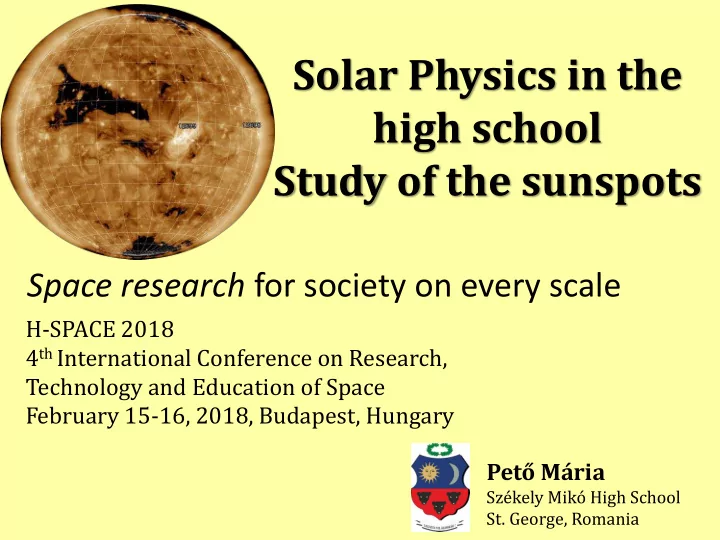

Solar Physics in the high school Study of the sunspots Space research for society on every scale H-SPACE 2018 4 th International Conference on Research, Technology and Education of Space February 15-16, 2018, Budapest, Hungary Pető Mária Székely Mikó High School St. George, Romania
Observing the Sun Pinhole camera
The overall goal of this workshop is to follow the evolution of sunspots and to determine the differential rotation of the Sun at different latitudes with two methods. The purpose of the classroom activity is • to familiarize students with the possibilities of sunspots observing, • to calculate the differential rotation period of the Sun from the movement of sunspots and • to search for connection between sunspot activities and terrestrial processes, between terrestrial phenomena and space weather. These activities correspond for lower and upper secondary school students (12-14 and 14-18 years old).
At its poles the Sun’s rotation period is 35 days while at the equator is 25 days. This is known as differential rotation. The Sun behaves as a dynamo .
Workshop activity for 7-8th grade students or humanity classes. • Every group get a paper with 12 or 16 images of the Sun, which was taken on different days at the same time. We use: http://fenyi.solarobs.unideb.hu/ESA/HMIDD.html • Collect and record sunspot data; • The selected sunspots are followed from their appearance until disappearance. • Using the daily-obtained data, they calculate the movement of the sunspot in terms of distance, angle (α) and the time that has elapsed between the two observations (Δt) . • Based on this, they calculate the rotation period (T Sun ) and speed (v Sun ) of the Sun.
R SUN = 6,9598* 10 5 km the radius of the Sun ∆𝛽 2𝜌 ∆𝑢 𝜕 = ∆𝑢 angular speed; 𝑈 = 𝜕 = 2𝜌 ∆𝛽 differential period of rotation; 2𝜌𝑆 𝑤 = 𝑈 rotation speed
SDO/HMI 2014 05 02; 07:30:00 http://solar-center.stanford.edu
Upper secondary school students activity arcsin(x/A) Sunspot - 12109, latitude S8 o 𝒚 = 𝑩𝒕𝒋𝒐 𝝏𝒖 Lineáris (arcsin(x/A)) 2 𝒚 1,5 y = 0,2348x - 1,5343 𝑩 = 𝐭𝐣𝐨 𝝏𝒖 1 𝐛𝐬𝐝𝐭𝐣𝐨 𝒚 𝑩 = 𝝏𝒖 0,5 arcsin (x/A) 0 2 July 3 July 4 July 5 July 6 July 7 July 8 July 9 July 10 July 11 July 12 July 13 July 14 July 𝝏 = 𝟏, 𝟑𝟒𝟓𝟗𝒔𝒃𝒆 -0,5 𝒆𝒃𝒛 -1 𝑼 = 𝟑𝝆 𝝏 = 𝟑𝟔, 𝟖𝟔𝟘𝟖𝒆𝒃𝒛 -1,5 -2
Workshop for upper secondary school students using SOHO Science Archive and Aladin sky atlas a). SOHO Science Archive: http://ssa.esac.esa.int/ssa/ssa.jnlp b). Aladin (Virtual Observatory) interactive sky atlas: http://aladin.u-strasbg.fr/java/nph-aladin.pl?frame=downloading
For example: selected period 14.12.2009. 23:59:o1-25. 12. 2009. 23:59:o1. Send the selected imagines to Aladin software. Using this picture we determine the coordinates of the sunspot (x and y) and the radius of the sun. Y Y X X centre centre arcsin Longitude arcsin Latitude R R SUN SUN = Δα/Δ t T=2 sin α= y/R α= arcsiny/R Δα=Δ b date time (t) x y R 2oo9. 23:59:01 -49,5 258 250,08 -0,1979367 -0,199252484 1,217260566 0,202876761 30,970453 day dec.14. 2oo9. latitude: 23:59:01 400 258 470 0,85106383 1,018008081 dec.2o. 38,327
Sunspots close the sun equator: T=25,411176day differential rotation; 0,247255 rad/day
References: ESA/GTTP Teacher Training Workshop 2010, Amsterdam. ESAC SOHO Science Archive tutorial, editors: L. Sanchez, D. Baines, P. Osasuna, ESAC Science Archives and Virtual Observatory Team, 2o14; EAAE-ESO Summer School Garching, Proceedings, 2007. Kálmán B. Mi a baj a napfoltokkal?, Fizikai Szemle 2013/11. 365.o. Eyes on the Skies- 400 years of Telescopic Discovery, Editors: G. Schilling, L. Lindberg Christensen; Wiley-VCH Verlag, Darmstadt. ISBN 978-3-527-40865-8. http://www.scholarpedia.org/article/Solar_activity http://www.spaceref.com/ http://fizikaiszemle.hu/archivum/fsz1311/kalman1311.html http://sohodata.nascom.nasa.gov/cgi-bin/data_query https://sohowww.nascom.nasa.gov/data/realtime/realtime-update.html http://www.spaceweather.com/ http://spaceweather.com/glossary/sunspotnumber.html http://fenyi.solarobs.csfk.mta.hu/en/databases/SOHO/ https://solarscience.msfc.nasa.gov/SunspotCycle.shtml https://sdo.gsfc.nasa.gov/data/ https://solarmonitor.org/
Münzlinger Attila, 2o11. Münzlinger Attila, 2o12. Thank you for your attention. I would like to acknowledge the support of the Content Pedagogy Research Program, MTA-ELTE Physics Education Research Group ( Project number 471027 ) of the Hungarian Academy of Sciences . Münzlinger Attila, 2o11.
Recommend
More recommend